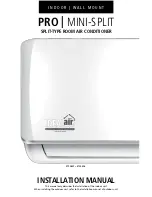
38
Heat up the unit for 12 hours after turning on the power
switch. Do not turn off the power supply if the unit is
designed to stop within 24 hours or less. (This is for
heating up the crankshaft heating box and avoiding
forced starting of the compressor.)
Do not block the air inlet and outlet.
Blockage may reduce the unit efficiency or activate the
protector to shut down the unit.
Operate the switch and button with an insulation rod
(such as a ball pen with a cap) to avoid the contact with
energized parts.
Caution
18 Commissioning
18.1 Overview
After installation, and once the field settings have been defined,
the installation personnel must verify the correctness of the
operations. Follow the steps below to perform the test run.
This chapter describes how the test run can be carried out once
the installation is complete, and other relevant information.
The test run usually includes the following stages:
1. Review the "Checklist Test Run".
2. Implement the test run.
3. Conduct troubleshooting before the test run is completed with
faults, if necessary.
4. Run the system.
18.2 Things to Note During Test Run
During the test run, the outdoor unit operates at the
same time as the indoor units connected to it. It is very
dangerous to debug the indoor unit during the test run.
Do not insert fingers, sticks, or other items into the air
inlet or outlet. Do not remove the fan mesh cover. If the
fan is rotating at a high speed, it may cause bodily injury.
Warning
Note that the required input power may be higher when
this unit is run for the first time. This phenomenon is due
to the compressor which needs to run for 50 hours before
it can achieve a stable operating and power consumption
state. Ensure that power has been on for 12 hours and
the crankcase heater has been charged correctly before
operation. This is a good way to protect the compressor.
Caution
A test run can be performed if the ambient temperature is
within the range indicated in Figure 18-1.
Information
-20 -5 5 30 55
Test run
(heating)
Test run
(cooling)
Out of
limit
Average indoor ambient
temperature /°C
Figure 18-1
18.3 Test Run Checklist
Once this unit is installed, check the following items first. After all
following checks have been completed, you must shut down the
unit. This is the only way to start the unit again.
Table 18-1
□
Installation
Check if the unit is installed correctly to prevent strange
noises and vibrations from occurring when the unit starts.
□
Field wiring
Based on the wiring diagram and the relevant
regulations, make sure the field wiring is based on
instructions described in Section 16.2 and Section 16.3
on connecting wires.
□
Grounding wire
Make sure the grounding wire is connected correctly, and
the grounding terminal is tight.
□
Insulation test of main circuit
Use the megameter of 500 V, apply a voltage of 500 V DC
between the power terminal and the grounding terminal.
Check that the insulation resistance is above 2 MΩ. Do
not use the megameter on the transmission line.
□
Fuses, circuit breakers, or protection devices
Ensure that the fuses, circuit breakers, or locally installed
protection devices comply with the size and type specified
in "16.1 Requirements for Safety Devices". Make sure you
use fuses and protection devices.
□
Internal wiring
Visually inspect if the connections between the electrical
component box and the interior of the unit is loose, or if
the electrical components are damaged.
□
Piping dimensions and insulation
Make sure the installation piping dimensions are correct,
and the insulation work can be carried out normally.
□
Stop valve
Make sure the stop valve is open on both the liquid and
gas sides.
□
Equipment damage
Check for damaged components and extruded piping
inside the unit.
□
Refrigerant leak
Check the inside of the unit for refrigerant leak. If a leak
exists, keep the area ventilated to avoid refrigerant
accumulation and eliminate/put out any open flames. Do
not touch the refrigerant leaked from the refrigerant piping
connection. It may cause frostbite.
□
Oil leak
Check if there is oil leaking from the compressor. If an oil
leak occurs, please turn off the power supply and contact
the distributor.
□
Air inlet/outlet
Check for paper, cardboard or any other material that
may obstruct the air inlet and outlet of the equipment.
□
Charge additional refrigerant.
Indicate the amount of refrigerant to be charged to the
unit in the "Confirmation Table" on the front cover of the
electrical control box.
□
Installation date and field settings
Record the installation date and field settings.
Содержание KMF-80 DVR5
Страница 67: ...16127000005207...
Страница 68: ......
















































